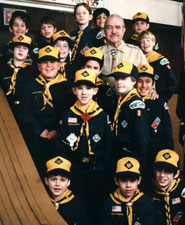
What a Birthday Party!
By Robert Peterson
Photographs courtesy of the BSA Archives and
the National Scouting Museum Archives
From coast to coast, Cub Scout packs are celebrating "75 Years of Fun, Family, and Friends."
- Celebration Began With Fall Events
- Connecticut Pack Was In On the Beginning
- Join the Celebration And Earn Awards
A 75th birthday celebration is taking place across the country. But rather than showing any signs of aging, the guest of honor appears stronger and more vital than ever.
Since September, nearly two million Cub Scouts, Webelos Scouts, and Tiger Cubs from some 50,000 packs—along with more than a half-million adult volunteers and countless family members—have been celebrating the diamond anniversary of the BSA program for younger boys and families. The party will continue through December of this year.
***
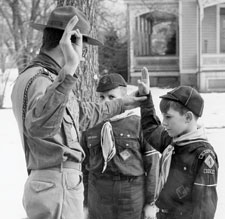 Early dens were led by Boy Scout den chiefs. |
Launched in 1930, Cub Scouting in the United States had a long gestation period. Almost two decades earlier, shortly after the BSA's founding in 1910, the National Executive Board asked Ernest Thompson Seton—famed artist, outdoorsman, youth leader, and BSA founding father—to devise a program for boys under 12 years old (at the time the minimum age for becoming a Boy Scout).
The resulting plan for "Cubs of America" featured activities for younger boys organized in small groups called "rings" to be led by a "Cub mother."
Meanwhile, in England in 1916, Robert S.S. Baden-Powell, Scouting's founder, formed Wolf Cubs for younger boys. It was a kind of "junior Scouting" with the younger boys joining Boy Scouts for outdoor activities, including camping. Within a year or two, Wolf Cub groups, using the British program, became active across the United States (see sidebar).
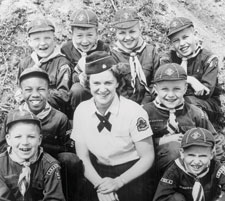 Den leaders make sure that meetings include learning experiences and plenty of fun. |
Finally, in 1924 the National Executive Board approved the idea, and studies began under the leadership of H. W. Hurt, Ph.D., a Scouter and educator.
Six years later, in April 1930, Cubbing, as it was first called, designed for boys 9 through 11 years old, was launched as an official experimental program—and enjoyed immediate success.
Within a decade more than a quarter-million boys and 50,000 adult leaders had enrolled.
***
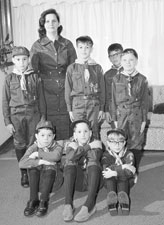 By the 1940's and 50's, den mothers had become a key top Cub Scouting's success. |
Three-quarters of Cubbers (as leaders were called) were new to Scouting. Dens were led by Boy Scout den chiefs and packs by male Cubmasters and pack committeemen.
The first Den Mother's Denbook, published a year later, advised the women to "keep somewhat in the background, making the den chief the important figure in the den meeting."
Dens met weekly, usually in a home. Activities included opening and closing ceremonies, games, crafts, work on advancement, and preparation of a skit or stunt for a pack meeting.
At first, pack meetings were also weekly, then semimonthly. One of the two meetings each month featured an afternoon of games for the boys, while the other was an evening meeting for both Cub Scouts and parents, similar to today's pack meetings.
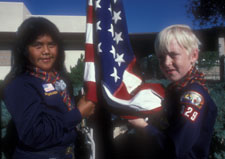 In 1967, Webelos Scouting became a separate program. |
Monthly program themes did not come into vogue until 1940, so pack meetings in the first decade were rather formless, although some packs held circuses and pet and hobby shows.
In November 1933, leaders began receiving a monthly pamphlet titled Cub Leaders' Round Table, offering ideas for games, songs, skits, and ceremonies.
Monthly roundtables providing adult leaders with a forum for sharing program ideas and news first appeared in the Sequoia Area Council in Fresno, Calif., in the late 1930's.
By the World War II years, the monthly sessions were common across the country. Roundtables then were more discussion forums than practice sessions for crafts, games, and ceremonies. Such skills were taught at annual gatherings of Cub Scout leaders in local councils. These started during the war years and came to be called "pow wows" about 1950.
The Cub Scout's advancement progressed from Bobcat (for all new members), to Wolf for 9-year-olds, Bear for l0-year-olds, to Lion for 11-year-olds.
In 1949, age levels for ranks were reduced by a year. Five years later, 10-and-a-half-year-olds with the Lion rank were put into a "Webelos den" to prepare to move into Boy Scouting.
***
 A fitness program was launched in 1974. |
By 1960, helped by the postwar baby boom, Cub Scout membership had grown to 2.7 million. But leaders were concerned that 30 percent of the boys were not staying long enough to earn their Lion Award. As a result, in 1967 a major revision to the program was introduced, with 10-year-old Cub Scouts going into separate dens in a new Webelos Scouting program.
The new program gave 10-year-old boys more outdoor activities and contact with Boy Scout troops. Its advancement program covered 15 vocational and hobby fields in the form of activity badges.
The Webelos Scout program continued to evolve in the 1980's:
- Dens were given the option of wearing a Boy Scout-style uniform
- In order for boys to move up with their friends, membership was determined by grade level rather than birth date
- Separate schedules of activities were offered for fourth-grade and fifth-grade Webelos dens.
 The Tiger Cub program was introduced in 1982. |
In 1982, Tiger Cubs U.S.A. was born. Now, 7-year-old boys could join Cub Scouting with a parent in a group headed by an adult Tiger Coach. In 1995, Tiger groups became dens in the pack.
***
Over the decades Cub Scouting added activities like the pinewood derby, first staged by a pack in Manhattan Beach, Calif., in 1953. In 1968, day camps were approved by the national committee; safe bicycling and physical fitness programs were introduced in 1974, and a sports program in the 1980's.
The 1990's program known as Ethics in Action, a series of character-development activities, later evolved into Character Connections, a program that encourages a discussion of one of 12 core values in every Cub Scouting activity.
***
In seven and a half decades, more than 57 million boys, guided by the leadership of 16 million adult volunteers, have shared the Cub Scouting experience of "Fun, Family, and Friends." And in the decades to come, Cub Scouting promises to continue delivering effective character, citizenship, and personal fitness training to more boys than ever.
Contributing editor Robert Peterson is the author of The Boy Scouts: An American Adventure. More articles on Cub Scouting history are available on the Scouting magazine Web site, www.scoutingmagazine.org. (Click on Search and then on Scouting History.)
Celebration Began With Fall EventsThe 16-month celebration of Cub Scouting's "75 Years of Fun, Family, and Friends" takes place from September 2004 through December 2005. The official birthday observance will be during Scouting Anniversary Week, but councils, packs, and dens will participate in special events and activities during all 16 months. Many ideas for pack and den anniversary activities are included in Cub Scout Program Helps 2004-05 (BSA No. 34304), which includes a special guide for incorporating anniversary activities into each monthly pack theme. In addition to a special anniversary celebration at the blue and gold banquet in February, packs are urged to plan a community service project or other anniversary event. *** Some councils started the celebration with major activities in the fall. For example, the Mid-Iowa Council, based in Des Moines, launched a traveling 75th Cub Scout Anniversary promotion, used at the council's pow wow on Nov. 6 and at district roundtables in November and December. The display consists of three life-size replicas of the 75th Cub Scout Anniversary logo with Tiger, Wolf, and Bear; coloring contest sheets for Cub Scouts to submit to the council; and promotional packets with ideas for celebrations. Also in Iowa, the Winnebago Council in Waterloo marked Cub Scouting's milestone with an October weekend "camp-in" for Cub Scouts and parents at the University of Northern Iowa's UNI-Dome stadium. The boys and parents attended UNI's Saturday afternoon football game, then camped in the UNI-Dome, where they participated in such activities as swimming, rock-climbing, basketball, archery, and pinewood derby racing. "It was part of our fall recruitment effort," said senior district executive Lane LeBahn, staff adviser for the camp-in. "We had more than 1,300 who camped and an additional 200 who came for the game only." — R.P. |
Connecticut Pack Was In On the BeginningLike Boy Scout troops all across the country, Troop 3 in the Housatonic Council, Derby, Conn., attracted a lot of younger brothers to its meetings during the 1920's, when boys had to be 12 years old to become Boy Scouts. In 1927, the Troop 3 Scoutmaster asked patrol leader Edmund D. Strang, 17, to do what many other troops had been doing since the founding of the BSA: form a "junior troop" for the dozens of younger brothers attending every meeting.
The junior troop he organized eventually became Pack 3 of the Derby United Methodist Church. After a year of haphazard meetings, Strang heard about the British Wolf Cub program, which had been started in 1916 by Robert S.S. Baden-Powell, Scouting's founder. He sent away for Wolf Cub books, and soon his 37 Cubs were earning badges called Tenderpad, One-Star, Two-Star, and Three-Star awards. "The Wolf Cub program was like 'junior Scouting,'" Strang recalled. "There was a little knot-tying and a little bit of other things the kids would eventually use in Scouting." Shortly after the BSA introduced Cub Scouting as a national program in April 1930, Pack 3 became the 38th pack to be chartered. Ed Strang was the first Cubmaster, remaining active in the pack and its brother troop and Explorer post until his death in 1995. Troop 3 committee chairman Randy Ritter, a former Pack 3 member, said the pack will mark Cub Scouting's 75 years with a reunion of former Cub Scouts in March. — R.P. |
Join the Celebration And Earn AwardsA variety of awards programs can help stimulate participation by Cub Scouts and families during Cub Scouting's 75th anniversary year. 
Full requirements and other details on the awards program are available at local Scout council service centers. |
January - February 2005 Table of Contents
Copyright © 2005 by the Boy Scouts of America. All rights thereunder reserved; anything appearing in Scouting magazine or on its Web site may not be reprinted either wholly or in part without written permission. Because of freedom given authors, opinions may not reflect official concurrence.
